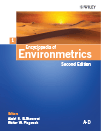Exceedance Over Threshold†
First published: 15 January 2013
†
Based in part on the article “Exceedance over threshold” by Holger Drees, which appeared in the Encyclopedia of Environmetrics.
Abstract
We consider methods from extreme value statistics to fit threshold models to univariate or multivariate samples. Moreover, the influence of serial dependence between observations on the estimation accuracy and on quantities of interest, such as return levels, is discussed.
References
- 1 Hill, B.M. (1975). A simple general approach to inference about the tail of a distribution, The Annals of Statistics 3, 1163–1174.
- 2 Pickands, J. III (1975). Statistical inference using extreme order statistics, The Annals of Statistics 3, 119–131.
- 3 Grimshaw, S.D. (1993). Computing maximum likelihood estimates for the generalized Pareto distribution, Technometrics 35, 185–191.
- 4 Drees, H., Ferreira, A., & de Haan, L. (2004). On the maximum likelihood estimation of the extreme value index, Annals of Applied Probability 14, 1179–1201.
- 5 Smith, R.L. (1987). Estimating tails of probability distributions, The Annals of Statistics 15, 1174–1207.
- 6 Peng, L. & Qi, Y. (2009). Maximum likelihood estimation of extreme value index for irregular cases, Journal of Statistical Planning and Inference 139, 3361–3376.
- 7 Falk, M. (1995). Some best parameter estimates for distributions with finite endpoint, Statistics 27, 115–125.
- 8 Hosking, J.R.M. & Wallis, J.R. (1987). Parameter and quantile estimation for the generalized Pareto distribution, Technometrics 29, 339–349.
- 9 Dekkers, A.L.M., Einmahl, J.H.J., & de Haan, L. (1989). A moment estimator for the index of an extreme value distribution, The Annals of Statistics 17, 1833–1855.
- 10 Drees, H. (1998). A general class of estimators of the extreme value index, Journal of Statistical Planning and Inference 66, 95–112.
- 11 Drees, H. (1998). On smooth statistical tail functionals, Scandinavian Journal of Statistics 25, 187–210.
- 12 Drees, H., de Haan, L., & Resnick, S. (2000). How to make a Hill plot, The Annals of Statistics 28, 254–274.
- 13 Danielsson, J., de Haan, L., Peng, L., & de Vries, C.G. (2000). Using a bootstrap method to choose the sample fraction in tail index estimation, Journal of Multivariate Analysis 76, (2), 226–248.
- 14 Drees, H. & Kaufmann, E. (1998). Selecting the optimal sample fraction in univariate extreme value estimation, Stochastic Processes and Their Applications 75, 149–172.
- 15
Draisma, G.,
de Haan, L.,
Peng, L., &
Pereira, T.T.
(1999).
A bootstrap based method to achieve optimality in estimating the extreme-value index,
Extremes
2,
367–404.
10.1023/A:1009900215680 Google Scholar
- 16 Drees, H. (1998). Estimating the Extreme Value Index, Habilitation thesis, University of Cologne.
- 17 Beirlant, J., Teugels, J.L., & Vynckier, P. (1996). Tail index estimation, Pareto quantile plots, and regression diagnostics, Journal of the American Statistical Association 91, 1659–1667.
- 18
Beirlant, J.,
Teugels, J.L., &
Vynckier, P.
(1996).
Excess functions and estimation of the extreme-value index,
Bernoulli
2,
293–318.
10.2307/3318416 Google Scholar
- 19
Beirlant, J.,
Goegebeur, Y.,
Segers, J.,
Teugels, J.,
de Waal, D., &
Ferro, C.
(2004).
Statistics of Extremes,
John Wiley & Sons Ltd,
Chichester.
10.1002/0470012382 Google Scholar
- 20
Dietrich, D.,
de Haan, L., &
Hüsler, J.
(2002).
Testing extreme value conditions,
Extremes
5,
71–85.
10.1023/A:1020934126695 Google Scholar
- 21
de Haan, L. &
Ferreira, A.
(2006).
Extreme Value Theory,
Springer,
New York.
10.1007/0-387-34471-3 Google Scholar
- 22 Drees, H. (2000). Weighted approximations of tail processes for β-mixing random variables, Annals of Applied Probability 10, 1274–1301.
- 23 Drees, H. (2003). Extreme quantile estimation for dependent data with applications to finance, Bernoulli 9, 617–657.
- 24 Smith, R.L. & Weissman, I. (1994). Estimating the extremal index, Journal of the Royal Statistical Society, Series B 56, 515–528.
- 25
Embrechts, P.,
Klüppelberg, C., &
Mikosch, T.
(1997).
Modelling Extremal Events,
Springer-Verlag,
Berlin.
10.1007/978-3-642-33483-2 Google Scholar
- 26 Weissman, I. & Novak, S.Y. (1998). On blocks and runs estimators of the extremal index, Journal of Statistical Planning and Inference 66, 281–288.
- 27 Hsing, T. (1991). Estimating the parameters of rare events, Stochastic Processes and Their Applications 37, 117–139.
- 28 Ferro, C.A.T. & Segers, J. (2003). Inference for clusters of extreme values, Journal of the Royal Statistical Society, Series B 65, 545–556.
- 29 Segers, J. (2003). Functionals of clusters of extremes, Advances in Applied Probability 35, 1028–1045.
- 30 Einmahl, J.H.J. & Segers, J. (2009). Maximum empirical likelihood estimation of the spectral measure of an extreme-value distribution, The Annals of Statistics 37, 2953–2989.
- 31
de Haan, L. &
de Ronde, J.
(1998).
Sea and wind: multivariate extremes at work,
Extremes
1,
7–45.
10.1023/A:1009909800311 Google Scholar
- 32 Joe, H., Smith, R.L., & Weissman, I. (1992). Bivariate threshold models for extremes, Journal of the Royal Statistical Society, Series B 54, 171–183.
- 33 Draisma, G., Drees, H., Ferreira, A., & de Haan, L. (2004) Bivariate tail estimation: dependence in asymptotic independence. Bernoulli, 10, 251–280.
- 34 Drees, H. & Müller, P. (2008). Fitting and validation of a bivariate model for large claims, Insurance: Mathematics and Economics 42, 638–650.



